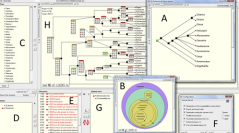

 Comptes Rendus Palevol
11 (8) - Pages 563-566
Comptes Rendus Palevol
11 (8) - Pages 563-566Within phylogenetics, two methods are known to implement cladistics: parsimony or maximum parsimony (MP) and three-item analysis (3ia). Despite the lack of suitable software, 3ia is occasionally used in systematic, and more regularly, in historical biogeography. Here, we present LisBeth, the first and only phylogenetic/biogeographic program freely available that uses the 3ia approach and offer some insights into its theoretical propositions. LisBeth does not rely on the conventional taxon/character matrix. Instead, characters are represented as rooted trees. LisBeth performs 3ia analyses based on maximum congruence of three-item statements and calculates the intersection tree (which differs from usual consensus). In biogeography, it applies the transparent method to handle widespread taxa and implements paralogy-free subtree analysis to remove redundant distributions. For the sake of interoperability, LisBeth may import/export characters from/to matrix in NEXUS format, allowing comparison with other cladistic programs. LisBeth also imports phylogenetic characters from Xper 2 knowledge bases.
Cladistics, Evolution, Phylogenetics, Historical biogeography